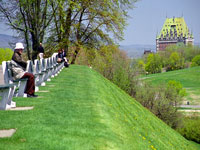
Once the setting for bloody battles between the British and the French, the Plains of Abraham today serve as Quebec City's primary 'green lung'. A playground and peaceful arboreal retreat, it's a venue for a variety of festivals, fairs, and events.The park is to Quebec what Central Park is to New York, covering 108 hectares and containing 6,000 trees, monuments, and interpretive centres. In winter, locals and visitors alike enjoy a giant skating rink and a few fun ski-tracks in the park. Summertime is ideal for strolling the fragrant gardens, jogging or rollerblading, and picnicking.
Address : Discovery Pavilion, 835 Wilfrid-Laurier Avenue
Website : www.ccbn-nbc.gc.ca
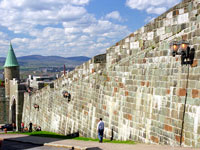
Guided walking tours of the three mile (5km) wall surrounding the Old City of Quebec trace the evolution of the city's defence system across three centuries. The walls were built between 1608 and 1871 as part of the fortifications in the area, which was the region's main colonial stronghold. The walls are set with interpretation panels and can be explored independently.Following the walls is a wonderful way to explore the old city and visitors will pass many interesting sights in the historic centre along the way, including the Esplanade Powder Magazine. Quebec is the only surviving fortified city in North America and this fact contributed to its being named a World Heritage City.
Address : 100 Rue Saint-Louis (tours depart from the Frontenac kiosk, Dufferin Terrace)
Website : www.pc.gc.ca/fortifications
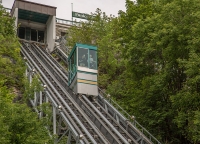
A panoramic bird's eye view of historic Quebec City can be had from the cabin of the funicular that travels at a 45 degree angle from Louis Jolliet House in the heart of the Old City to Dufferin Terrace. The funicular has been an attraction in the city since the original steam driven version was erected in 1879.Claustrophobic visitors may not enjoy the trip up in the little compartments, but most will relish the views and novel mode of getting around. The walk down from the Old City is pleasant and easy, but the walk up can be rather painful. Many people choose to take the funicular up and walk back down.
Address : 16 Rue du Petit Champlain
Website : https://www.quebecregion.com/en/businesses/attractions/tourist-sites/funiculaire-du-vieux-quebec/
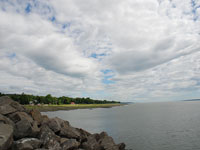
The little island in the Saint Lawrence River, just 15 minutes from downtown Quebec City, is an historical treasure trove containing 600 heritage buildings. Algonquin natives called the island Windigo, meaning 'bewitched corner', before French colonists arrived in 1535 and named it for the Duke of Orleans.The island is the ancestral home of more than 300 Quebecois families and still has more than 7,000 inhabitants. A perimeter road called the Royal Way, which extends across the Taschereau Bridge to the mainland, connects all the six villages on the island. Visitors enjoy cycling or driving around the island to marvel at panoramic views of the river and explore sites like the oldest church in New France.
Address : 9 miles (15 km) from Quebec City
Website : http://tourisme.iledorleans.com/en/
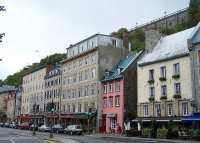
Basse-Ville is Quebec City's Lower Town, a charming old quarter full of narrow, winding streets, historical stone buildings, and an overwhelming array of trendy cafes, bars, and boutique stores. The oldest urban district in Canada, Lower Town has a distinctly European feel to it. Recent efforts to gentrify the area have been undertaken with appropriate sensitivity and class, resulting in postcard-perfect photo opportunities lying in wait on every street corner.Lower Town is also home to many of Quebec City's most celebrated sights and attractions, including the Place Royale, Petit Champlain, and the must-see Funicular. The heart and soul of Old Quebec, Lower Town is a beguiling and enchanting neighbourhood. All visitors to Quebec City should anticipate spending a lot of time walking its streets and soaking up its unique atmosphere.
Address : On the banks of the St Lawrence River
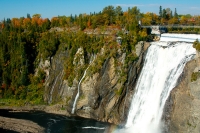
Just to the east of Quebec City lies the spectacular Montmorency Falls which plunges 272 feet (83m), one and a half times higher than Niagara Falls. Besides a beautiful setting, the park also boasts historic buildings and a variety of fun activities. A cable car runs up to the historic Manoir Montmorency manor house, dating from 1781, where there is a restaurant, viewing terrace, interpretation centre, reception rooms, and boutiques. A suspension bridge hangs directly across the falls, providing a breathtaking view, and a second bridge gives access to the east side of the falls where there are numerous viewpoints and trails.
Address : Avenue Royale, Beauport
Website : www.sepaq.com/chutemontmorency
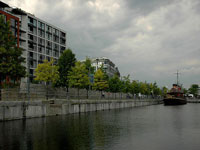
Montreal's Old Port is actually fairly new, having undergone a major facelift to make it the most popular site in the city. Named Vieux Port de Montreal in French, it draws some five million visitors each year to its bustling wharves.In the 19th century, the port of Quebec on the Saint Lawrence River was one of the most important in the world, with thousands of ships and sailors passing through. There are still plenty of boats in evidence but nowadays they are mainly tour boats, ferries, and amphibious buses, offering trips along the river or around the port. Ferries cross to the Parc des Iles, site of the Expo 67 World's Fair, which lies in the Saint Lawrence and offers facilities for picnicking, swimming, and skating and skiing in winter.The Old Port itself is a thriving arts and entertainment venue where something is always happening. It also offers a huge open-air skating rink, IMAX cinema, vibrant cafes, and a Science and Technology Center with interactive displays.The clock tower offers excellent views across the city and contains an exhibition that traces Montreal's history. Around the port are the city's original 17th-century fortifications, while characters in period costume conduct guided tours through the streets and alleys and point out the points of historic significance.
Address : 333 Rue de la Commune Ouest
Website : www.vieux.montreal.qc.ca
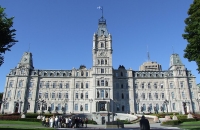
Just outside the old city walls stands the imposing 19th-century Parliament Building, inspired by the Louvre in Paris and designed by the architect, Eugene Etienne Taché. Although it is the working home of the 125-strong National Assembly, the buildings are open to visitors for free guided tours, offered in English or French, which highlight the historic value of the unique building as well as informing visitors about the organisation and proceedings of the Québec National Assembly. Tours should be organised in advance for groups of 10 or more. There is a restaurant and a gift shop at the Parliament Building.
Address : 1045 Parlementaires Road (visitor’s entrance: Door 3 on the corner of Grande-Allée and Honoré-Mercier Avenue)
Website : www.assnat.qc.ca
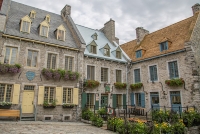
The site of the historical Place-Royale complex was used in ancient times for trading by the First Nations, until the leader of the first Quebec French settlement, Samuel de Champlain, constructed a formal fortified fur trading post in 1608.The trading post flourished and grew into a thriving town, constructed largely of wood until it was destroyed by fire in 1682. Reconstruction was in fire-resistant stone, accounting for the buildings that still stand today. Known as the market square, the site once again became a hub of activity, until the end of the 19th century when its importance declined.By 1950, the Place-Royale was a neglected and decaying area. The Government then initiated a restoration programme that has turned this historic site, known as the 'birthplace of French America', into one of the city's main attractions. It features a clutch of interesting museums, living history demonstrations, and tours of historic buildings.
Address : Interpretation Centre of Place-Royale, 27 Rue Notre-Dame
Website : www.mcq.org

Travel Guide powered by Word Travels, copyright © 2023 Globe Media Ltd. By its very nature information in this travel guide is subject to change at short notice and travellers are urged to verify information on which they're relying with the relevant authorities. Neither Globe Media Ltd nor Travel Vogue can accept any responsibility for any loss or inconvenience to any person as a result of information contained above.